Table of Contents
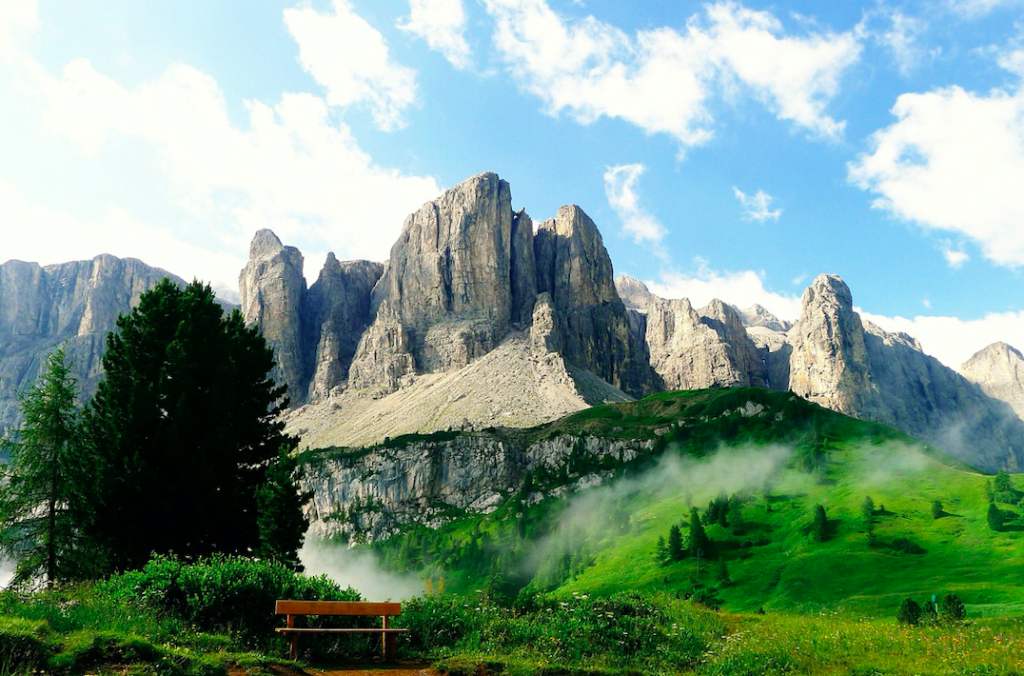
The Dolomites, a magnificent mountain range in northern Italy, have long captured the hearts of adventurers, nature lovers, and photographers. With their jagged peaks, verdant valleys, and idyllic alpine villages, the Dolomites are a UNESCO World Heritage site, recognized for both their stunning natural beauty and geological significance. Spanning across several regions including South Tyrol, Trentino, and Veneto, the Dolomites offer a rich blend of cultures, cuisines, and outdoor activities that make them a premier destination for travelers.
If you’re planning a trip to this beautiful region, this comprehensive guide will provide you with everything you need to know about how to get to the Dolomites, how to get around, where to stay, and what to see and do. Whether you’re embarking on a scenic road trip, exploring by public transport, or taking advantage of the region’s extensive network of cable cars, this guide has you covered!
Where Are the Dolomites?
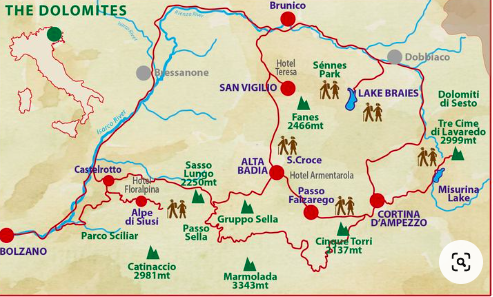
Before diving into the logistics of getting to the Dolomites, it’s essential to understand where this mountain range is located. The Dolomites are part of the Southern Limestone Alps and stretch across the northeastern regions of Italy, including South Tyrol (Alto Adige), Trentino, and Veneto. This region is characterised by its unique geology, with towering limestone peaks, lush valleys, and crystal-clear alpine lakes.
The Dolomites are divided into several subranges, each offering its own distinct landscapes and attractions. Some of the most famous areas within the Dolomites include:
- Val Gardena: A picturesque valley in South Tyrol, known for its charming villages like Ortisei, Selva di Val Gardena, and Santa Cristina. Val Gardena is a popular destination for both winter skiing and summer hiking.
- Alta Badia: Another beautiful valley in South Tyrol, known for its stunning landscapes, traditional Ladin culture, and excellent cuisine. Towns like Corvara, Colfosco, and La Villa are great bases for exploring the region.
- Cortina d’Ampezzo: Often referred to as the “Queen of the Dolomites,” Cortina is a glamorous resort town in Veneto, famous for its skiing, hiking, and upscale shopping.
- Tre Cime di Lavaredo: Located in the Sexten Dolomites, this trio of iconic peaks is one of the most photographed landmarks in the Dolomites and a must-visit for hikers and nature enthusiasts.
- Bolzano: The capital of South Tyrol, Bolzano serves as a gateway to the Dolomites and is known for its rich history, vibrant culture, and stunning mountain backdrop.
How to Get to the Dolomites
There are several ways to reach the Dolomites, depending on your starting point and preferred mode of transportation. Whether you’re flying into Italy, driving from a nearby country, or taking the train, you’ll find various options that suit your travel style and itinerary:
By Plane
If you’re coming from outside Europe, flying is likely the most logic option. The nearest major airport to the Dolomites is Venice Marco Polo Airport (VCE), which is approximately 150 kilometers (93 miles) from the Dolomites. Venice Marco Polo Airport is well-connected to major cities across Europe and beyond, making it a popular entry point for international travelers.
- Venice Marco Polo Airport (VCE): As the closest major airport to the Dolomites, Venice Marco Polo is your best bet for convenient flights. From the airport, you can rent a car, take a train, or hop on a bus to reach the Dolomites.
- Treviso Airport (TSF): Located about 30 kilometers (19 miles) from Venice, Treviso Airport is another option, especially if you’re flying with low-cost carriers like Ryanair. While smaller than Venice Marco Polo, Treviso Airport still offers good connections to many European cities.
- Verona Villafranca Airport (VRN): Located about 180 kilometers (112 miles) from the Dolomites, Verona’s airport is another alternative for reaching the region. It’s slightly further away, but still within a reasonable driving distance.
- Bolzano Airport (BZO): If you’re flying within Italy or from nearby European countries, Bolzano Airport is the closest airport to the Dolomites. However, it’s a small airport with limited flight options, so it might not be as convenient for international travelers.
By Car
Driving is one of the best ways to explore the Dolomites, as it gives you the flexibility to create your own itinerary and visit off-the-beaten-path locations. A Dolomites road trip is an unforgettable experience, allowing you to take in the stunning scenery at your own pace.
- From Venice: If you’re flying into Venice Marco Polo Airport, you can rent a car directly at the airport and start your journey to the Dolomites. The drive from Venice to the Dolomites takes approximately 2.5 to 3 hours, depending on your destination. You’ll likely take the A27 highway towards Belluno, then follow the SS51 or SS52 roads into the heart of the Dolomites.
- From Milan: Milan is another popular starting point for a road trip to the Dolomites. The drive from Milan to the Dolomites takes about 4 hours, following the A4 highway eastward towards Verona, and then the A22 north towards Bolzano. From Bolzano, you can continue into the Dolomites via the SS242 road towards Val Gardena or the SS48 towards Alta Badia.
- From Austria or Germany: If you’re coming from Austria or Germany, you can drive into the Dolomites via the Brenner Pass, which connects Innsbruck in Austria to Bolzano in Italy. The A22 highway runs through the Brenner Pass and provides easy access to the Dolomites from the north.
When driving in the Dolomites, be prepared for narrow, winding mountain roads with plenty of hairpin turns. The views are spectacular, but the roads can be challenging, especially for those not used to mountain driving. Make sure your rental car is equipped with GPS and consider renting a vehicle with a manual transmission, as many of the roads in the region are better suited to manual cars.
By Train
Taking the train to the Dolomites is a comfortable, sustainable and scenic option, especially if you’re traveling from within Italy or neighboring countries. While there are no direct trains into the heart of the Dolomites, you can reach several nearby towns and cities by train, and then continue your journey by bus, taxi, or rental car.
- From Venice: If you’re starting in Venice, you can take a train to Bolzano (Bozen in German), the capital of South Tyrol and the gateway to the Dolomites. The train journey from Venice to Bolzano takes about 3.5 to 4 hours, with a transfer in Verona. Once in Bolzano, you can take a bus or rent a car to explore the Dolomites.
- From Milan: Trains from Milan to Bolzano also take about 4 hours, with a transfer in Verona. Alternatively, you can take a train to Trento or Bressanone (Brixen), both of which are well-connected to the Dolomites by public transport.
- From Austria or Germany: If you’re traveling from Austria or Germany, you can take a train to Innsbruck and then transfer to an Italian train heading south through the Brenner Pass to Bolzano. The journey from Innsbruck to Bolzano takes about 2 hours, making it a convenient option for travelers from the north.
- San Candido (Innichen): If you’re heading to the eastern Dolomites, such as the Tre Cime di Lavaredo area, consider taking the train to San Candido, a charming town near the Austrian border. Trains from Bolzano to San Candido take about 2 hours, and from there, you can catch a bus or taxi to your destination.
By Bus
For those who prefer not to drive or take the train, buses are a viable option for reaching the Dolomites. Several bus services operate from major cities like Venice, Verona, and Milan directly to towns in the Dolomites, such as Cortina d’Ampezzo, Val Gardena, and Alta Badia.
- From Venice: The Cortina Express is a popular bus service that runs from Venice Marco Polo Airport and Venice Mestre to Cortina d’Ampezzo. The journey takes about 2.5 hours, making it a convenient option for travelers looking to avoid the hassle of driving.
- From Milan and Verona: The FlixBus network offers routes from Milan and Verona to various towns in the Dolomites, including Bolzano, Trento, and Cortina d’Ampezzo. FlixBus is known for its affordable fares and comfortable coaches, making it a great choice for budget-conscious travelers.
- Local Buses: Once you’re in the Dolomites, local buses operated by Südtirol Mobil and other regional transport companies connect the various towns, villages, and hiking trailheads. Public transport is especially reliable during the summer and winter seasons, when tourism is at its peak.
Getting Around the Dolomites
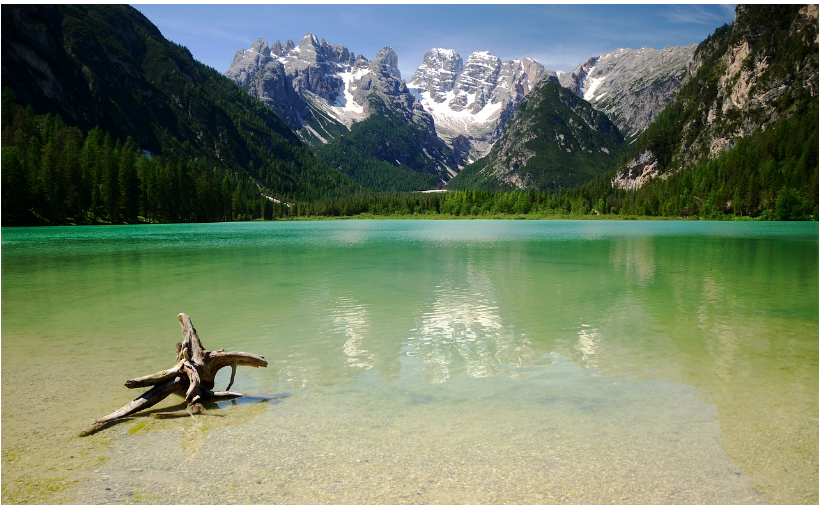
Once you’ve arrived in the Dolomites, getting around the region can be done by car, public transport, or even by using the extensive network of cable cars that offer stunning views and easy access to high-altitude trails.
By Car
Having a rental car is probably one of the best way to explore the Dolomites, as it allows you to visit remote areas, change your plans on the fly, and enjoy the scenic drives at your own pace. The roads in the Dolomites are well-maintained, but they can be narrow and winding, especially as you ascend into the higher elevations.
When planning your Dolomites road trip, consider the following tips:
- Plan Your Routes: The Dolomites are a large region, so it’s important to plan your routes in advance to make the most of your time. Use a GPS or a reliable map app to navigate the mountain roads, and be prepared for the occasional detour due to road closures or construction.
- Parking: Parking is generally available at most trailheads, villages, and attractions, but it can fill up quickly during the peak tourist season. It’s a good idea to arrive early in the day, especially if you’re visiting popular spots like Tre Cime di Lavaredo or Lago di Braies.
- Mountain Passes: The Dolomites are famous for their spectacular mountain passes, such as the Passo Sella, Passo Gardena, and Passo Pordoi. These passes offer some of the most breathtaking views in the region, but they can also be challenging to drive, particularly in bad weather. Always check the weather forecast before setting out, and be prepared for sudden changes in conditions.
- Fuel: Gas stations are available throughout the Dolomites, but they can be sparse in more remote areas. Make sure to fill up your tank whenever you pass a station, especially if you’re planning a long drive through the mountains.
By Public Transport
Public transport in the Dolomites is efficient and well-coordinated, especially during the summer and winter seasons when tourism is at its peak. Buses and trains connect the major towns, villages, and attractions, making it possible to explore the region without a car.
- Buses: Local buses are operated by companies like Südtirol Mobil and Trentino Trasporti, and they connect most towns and villages in the Dolomites. Bus services are frequent during the summer and winter, with routes that serve popular hiking trails, ski resorts, and tourist attractions.
- Trains: While the train network in the Dolomites is not as extensive as the bus network, there are a few key train lines that connect the region to other parts of Italy and Austria. The most important train stations in the Dolomites are in Bolzano, Bressanone, and San Candido.
- Guest Cards: Many hotels and accommodations in the Dolomites offer guest cards that provide free or discounted access to public transport. For example, the Val Gardena Mobil Card allows you to use all buses in Val Gardena and the surrounding area for free during your stay. Be sure to ask your accommodation about any available guest cards.
By Cable Car
The Dolomites are home to an extensive network of cable cars and chairlifts that provide easy access to high-altitude hiking trails, panoramic viewpoints, and ski slopes. Riding a cable car is not only a convenient way to get around, but it’s also an experience in itself, offering breathtaking views of the surrounding mountains and valleys.
- Seceda Cable Car: Located in Ortisei, the Seceda cable car takes you up to 2,500 meters (8,200 feet) above sea level, where you’ll find some of the most stunning views in the Dolomites. From the top, you can access several hiking trails, including the famous Seceda ridge walk.
- Lagazuoi Cable Car: This cable car near Cortina d’Ampezzo takes you up to the Lagazuoi peak, where you can explore World War I tunnels, enjoy panoramic views, and hike along scenic trails.
- Sass Pordoi Cable Car: Known as the “Terrace of the Dolomites,” the Sass Pordoi cable car takes you to an altitude of 2,950 meters (9,680 feet) on the Pordoi Pass. The views from the top are nothing short of spectacular, with vistas of the Marmolada, the highest peak in the Dolomites, and the surrounding valleys.
- Tre Cime di Lavaredo Shuttle: During the peak summer season, a shuttle bus service runs from the parking lot at Lago di Misurina to the Rifugio Auronzo, the starting point for the famous hike around the Tre Cime di Lavaredo. This shuttle is a great alternative if you prefer not to drive up the steep mountain road.
Where to Stay in the Dolomites
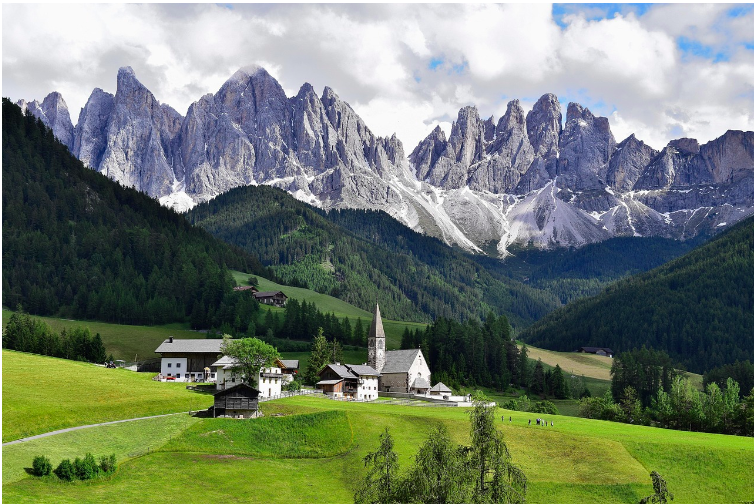
Accommodation options in the Dolomites are diverse, ranging from luxurious hotels and cozy alpine lodges to charming guesthouses and traditional mountain huts (rifugi). Where you stay will depend on your budget, travel style, and the areas you plan to explore.
Mid-Range Hotels and Guesthouses
For those on a mid-range budget, the Dolomites offer plenty of charming hotels and guesthouses that provide comfort and convenience without breaking the bank.
- Hotel Angelo Engel (Ortisei): This family-run hotel in the heart of Ortisei offers comfortable rooms, a wellness center, and a restaurant serving traditional South Tyrolean cuisine. It’s a great choice for those looking to explore Val Gardena.
- Hotel La Perla (Corvara): Located in Alta Badia, this four-star hotel offers cozy rooms, a spa, and a Michelin-starred restaurant. The hotel’s location makes it an excellent base for exploring the nearby hiking trails and ski slopes.
- Albergo al Sole (San Martino di Castrozza): This charming guesthouse in the eastern Dolomites offers comfortable accommodations and a warm, welcoming atmosphere. It’s a great option for travelers looking to explore the Pale di San Martino range.
Mountain Huts (Rifugi)
For a more authentic alpine experience, consider staying in a traditional mountain hut (rifugio). These huts are typically located at high altitudes and offer basic accommodations, often in dormitory-style rooms. Staying in a rifugio allows you to immerse yourself in the natural beauty of the Dolomites and wake up to breathtaking mountain views.
- Rifugio Lagazuoi: Located at 2,752 meters (9,029 feet) above sea level, this mountain hut offers some of the best views in the Dolomites. It’s accessible via the Lagazuoi cable car and is a popular stop for hikers and climbers.
- Rifugio Auronzo: Situated at the base of the Tre Cime di Lavaredo, this rifugio is a great base for exploring the famous peaks. The hut offers basic accommodations and a restaurant serving hearty alpine fare.
- Rifugio Alpe di Tires: Located in the heart of the Catinaccio/ Rosengarten range, this mountain hut offers stunning views of the surrounding peaks and easy access to some of the region’s best hiking trails.
What to See and Do in the Dolomites
The Dolomites are a paradise for outdoor enthusiasts, offering a wide range of activities from hiking and climbing to skiing and snowboarding. Whether you’re visiting in summer or winter, there’s no shortage of things to see and do.
Hiking and Walking
Hiking is one of the most popular activities in the Dolomites, with trails ranging from easy walks to challenging multi-day treks. The region is known for its well-marked hiking trails, which offer stunning views of the mountains, valleys, and lakes.
- Tre Cime di Lavaredo: One of the most iconic hikes in the Dolomites, the trail around the Tre Cime di Lavaredo offers breathtaking views of the three peaks and the surrounding landscape. The hike is moderate in difficulty and takes about 3 to 4 hours to complete.
- Seceda Ridge Walk: Starting from the top of the Seceda cable car, this hike offers panoramic views of the Dolomites, including the Odle/Geisler peaks and the Val Gardena valley. The hike is relatively easy and takes about 2 to 3 hours.
- Lago di Braies: This stunning alpine lake is one of the most popular spots in the Dolomites. The easy walk around the lake takes about 1 to 1.5 hours and offers beautiful views of the turquoise waters and surrounding peaks.
- Alta Via 1: For those seeking a more challenging adventure, the Alta Via 1 is a multi-day trek that takes you through some of the most spectacular landscapes in the Dolomites. The trail covers over 120 kilometers (75 miles) and takes about 10 to 12 days to complete.
Via Ferrata
The Dolomites are famous for their via ferrata routes, which are protected climbing paths that allow you to traverse exposed rock faces and ridges using fixed cables, ladders, and bridges. Via ferrata is a thrilling way to experience the rugged beauty of the Dolomites, but it does require a good level of fitness and a head for heights.
- Via Ferrata Ivano Dibona: This classic via ferrata near Cortina d’Ampezzo offers stunning views of the Cristallo range and the surrounding valleys. The route is of moderate difficulty and takes about 6 to 8 hours to complete.
- Via Ferrata delle Bocchette: Located in the Brenta Dolomites, this famous via ferrata route offers spectacular views of the surrounding peaks and valleys. The route is challenging and requires a full day to complete.
- Via Ferrata Piz da Lech: Located in Alta Badia, this via ferrata is shorter but more technically challenging, offering steep climbs and exposed sections. It’s a great option for experienced climbers looking for a thrilling adventure.
Skiing and Snowboarding
In winter, the Dolomites transform into a world-class ski destination, with over 1,200 kilometers (745 miles) of slopes and 450 ski lifts. The region is part of the Dolomiti Superski area, which is one of the largest ski networks in the world.
- Cortina d’Ampezzo: Known as the “Queen of the Dolomites,” Cortina is one of the most famous ski resorts in the region. It offers a wide range of slopes for all skill levels, as well as stunning views of the surrounding peaks.
- Val Gardena: This valley is home to several ski resorts, including Selva di Val Gardena and Ortisei. The area is part of the Sella Ronda ski circuit, which allows you to ski around the Sella massif in a single day.
- Alta Badia: This ski area offers a mix of gentle slopes for beginners and challenging runs for advanced skiers. It’s also known for its gourmet ski huts, where you can enjoy delicious South Tyrolean cuisine.
- Marmolada Glacier: The Marmolada is the highest peak in the Dolomites, and its glacier offers some of the best skiing in the region. The slopes are suitable for advanced skiers, and the views from the top are simply breathtaking.
Exploring Villages and Culture
In addition to its natural beauty, the Dolomites are also home to charming villages and a rich cultural heritage. The region is a melting pot of Italian, German, and Ladin cultures, each with its own traditions, languages, and cuisines.
- Ortisei: This picturesque village in Val Gardena is known for its colorful houses, woodcarving tradition, and lively atmosphere. It’s a great place to explore local shops, visit the Museum Gherdëina, and enjoy a meal at a traditional restaurant.
- Cortina d’Ampezzo: In addition to its status as a ski resort, Cortina is also known for its upscale shops, art galleries, and vibrant après-ski scene. The town is a great place to soak up the local culture and enjoy a leisurely stroll through the historic center.
- San Candido: This charming town near the Austrian border is known for its beautiful Baroque architecture, including the impressive Innichen Abbey. San Candido is also a great base for exploring the Tre Cime di Lavaredo and the surrounding area.
- Bolzano: As the capital of South Tyrol, Bolzano is a vibrant city with a rich history and a unique blend of Italian and Austrian influences. Highlights include the Ötzi Museum, the Gothic-style Bolzano Cathedral, and the bustling Piazza Walther.
Final Tips for Your Dolomites Adventure
- Best Time to Visit: The best time to visit the Dolomites depends on your interests. Summer (June to September) is ideal for hiking, climbing, and enjoying the outdoors, while winter (December to March) is perfect for skiing and snowboarding. Fall (October to November) offers beautiful autumn colors, but some facilities may be closed as the region transitions from summer to winter.
- Weather: The weather in the Dolomites can be unpredictable, especially at higher altitudes. Be sure to pack layers, including a waterproof jacket, and check the weather forecast before heading out on any hikes or outdoor activities.
- Language: While Italian is the official language, German is widely spoken in South Tyrol, and Ladin is spoken in some valleys. English is also commonly spoken in tourist areas.
- Currency: The currency in Italy is the Euro (€). Credit cards are widely accepted, but it’s a good idea to carry some cash, especially in smaller villages and mountain huts.
- Travel Insurance: Given the outdoor activities and mountain terrain, it’s advisable to have travel insurance that covers adventure sports, including hiking and climbing (if you use my link you have 5% discounts!!!).
Exploring the Dolomites is a journey of a lifetime, offering unparalleled natural beauty, thrilling outdoor adventures, and a rich cultural experience. Whether you’re embarking on a scenic road trip, hiking the iconic trails, or simply soaking in the alpine atmosphere, the Dolomites are sure to leave you with unforgettable memories. So pack your bags, lace up your hiking boots, and get ready to discover one of Italy’s most stunning and diverse regions!
If you are visiting Dolomites you should also stop in Trento:
Trento: Visiting one of the “greenest” city in Italy
Disclaimer This blog post might contain affiliate links.
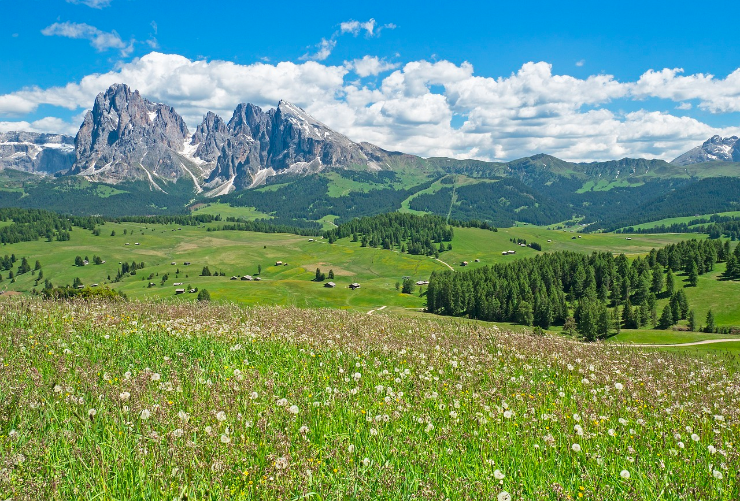
No Responses